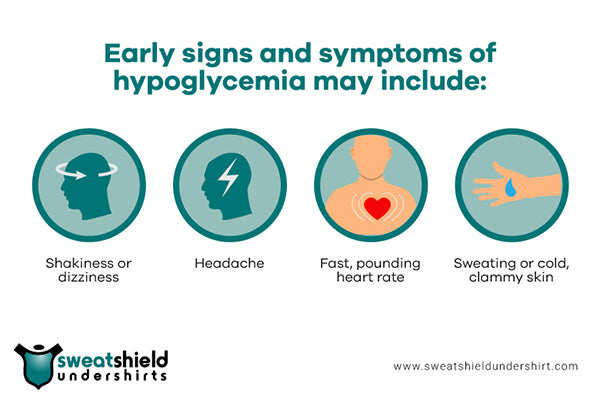Sweating without physical activity or heat happens as a result of cold sweats.
The medical term for cold sweating is diaphoresis.
Most people are already familiar with sweating, the body’s automatic cooling system. Cold sweats happen in cases of abrupt fear, pain or stress. It’s the body’s instinctive fight or flight response in action.
Quite a significant number of people break out in cold sweats from time to time. On its own, diaphoresis is not considered dangerous. However, it can also happen as a result of serious injury or sickness.
If anyone experiences cold sweating together with certain symptoms, they need to seek medical advice.
During a cold sweat, a person may appear paler than usual. They may report feeling cold, and their skin will feel cool or clammy to the touch.
Cold sweats usually appear on a person’s palms, underarms and the soles of their feet.
The seven leading causes of cold sweats include:
- Anxiety disorders
- Hypoglycemia
- Intense pain or shock
- Serious infection
- Drug or alcohol withdrawal
- Hormonal fluctuations
- Fainting
With diaphoresis, a person’s sweat glands become suddenly and, in most cases, abnormally triggered by physiological, psychological, or external factors.
The body’s fight or flight response dates to the origin of mankind. Early man needed it to figure out whether to fight or run away from predators and enemies.
Today, everyday situations can trigger a similar reaction. These include:
- Violent encounters
- Being trapped
- Traffic jams
- High-stress situations like public speaking and big presentations
Each person has their own stress response mechanism, but in a highly stressful encounter, a person’s heart rate accelerates. This can be followed by additional symptoms like:
- Rapid breathing
- Cottonmouth
- Damp hands
- Cold sweating
Let’s take a general look at how cold sweats are related to each of these conditions.
Anxiety Disorders
During an anxiety attack, it is not uncommon for a cold sweat to occur.
Examples of anxiety disorders linked to cold and clammy sweats are:
- Generalized social anxiety
- Panic disorder
Anxiety-related cold sweats are triggered by the amount of stress the body and brain go through.
During the anxiety attack, the amount of oxygen supplied to vital organs is limited.
Prolonged cases of anxiety can have negative effects on a person’s health long-term. If a person repeatedly has anxiety attacks, their quality of life can be impaired.
It’s best to look into professional assistance to deal with the root cause of anxiety-related cold sweats.
Hypoglycemia
When someone has low blood sugar levels, they can get cold sweats. This is a dangerous state to be in for people with diabetes.
The brain responds to a low blood sugar state in the same way as it would when there are low oxygen levels. This process precedes cold sweats, and at times, it leads to fainting.
Low blood sugar levels can quickly be resolved by having a light snack or drinking something with natural sugar, such as organic fruit juice.
It is not healthy to have repeated low blood sugar levels. Anyone with this symptom should seek professional advice.
Hormonal Fluctuations
During perimenopause or menopause, women sometimes experience cold sweats in addition to:
- Night sweats
- Hot flashes
- Cold sweats
There are specific medications that could trigger hormonal imbalance and cold sweating.
Hormones also become erratic as a result of:
- Thyroid disorders affecting the sweat glands
- Puberty
- Adolescence
- Pregnancy
Intense Pain or Shock
The fight or flight response is sometimes triggered by extreme pain. This could be due to:
- Accidents
- Violent attacks
- Migraines
Similarly, diaphoresis occurs when the body is in a state of shock, a condition characterized by low blood flow.
Cells and organs need enough oxygen and crucial nutrients to function. When the blood flow is low, they can suffer from irreparable damage
Symptoms pointing to shock shouldn’t be taken lightly. Any person with the following symptoms must be brought to emergency medical care immediately, after swift first aid care:
- Extremely cool, pale and clammy skin
- Chest pains
- Disorientation
- Dizziness or lightheadedness
- Extreme agitation
- Blue-tinted fingernails and lips
- Low urine
- Prolific sweating
- Rapid pulse
- Unconsciousness
Serious Infection
An extreme case of infection is referred to as sepsis.
Sepsis can be serious enough to trigger diaphoresis and shock at the same time.
Severe cases of infectious diseases such as HIV/AIDS cause the fight or flight reaction in the body. It is not uncommon for patients to report damp skin and extreme cases of sweating.
Infection puts the body in a constant state of panic. As the immune system tries to battle the disease, one of the resulting symptoms is a cold sweat.
Septic shock is common in:
- Aging people
- Infants or young children
- Critically sick patients
- Diabetes or cirrhosis patients
- Patients using invasive devices
- People with compromised immunities
- People with extreme wounds or injuries
- People reporting recent antibiotic or corticosteroid use
Drug or Alcohol Withdrawal
Diaphoresis is one of the side effects associated with drug and alcohol withdrawal.
Symptoms can set in as early as four hours from the last known drug use. These symptoms also endure beyond 12 hours in some cases. They may vary depending on a person’s level of dependence.
Drug dependence affects the brain directly. When it is deprived of the “feel good” neurochemicals, it will trigger the fight or flight reaction in the body.
The brain also responds to withdrawal with symptoms similar to a bad case of influenza.
In addition to cold sweats, withdrawal may also cause:
- Body aches
- Increased heart palpitations
- Nausea and vomiting
- Excessive sweating
- Insomnia
- Paranoia
- Confusion and disorientation
Fainting
Fainting is when a person loses consciousness without warning.
The medical term for this situation is syncope.
When blood pressure levels drop, the brain suffers from oxygen deficiency. Right before passing out, a person may experience cold sweats.
Circumstances leading to oxygen deficiency in the brain include:
- Extreme dehydration
- Excessive sweating caused by overheating
- Blood pooling in the legs
- Serious exhaustion
- Heart problems
Emerging fainting spells preceded by cold sweats could be a sign of something serious. Medical attention should be a top priority.
How to Cope With Cold Sweats
The best treatment course for cold sweats is to find and treat the underlying condition.
Some methods of coping with some of the symptoms include:
- Yoga and Meditation
- Stress management strategies to handle anxiety-related sweating
- Cognitive behavior therapy
- Daily physical activity or exercise
- Healthier diet choices
- Sustaining a healthy BMI
- Drinking enough water
- Using well-aerated garments
- Maintaining clean and dry skin
- Bathing regularly
- Hormone therapy solutions
- Prescription antiperspirants
Take Charge
Continuous cold sweats without known triggers could point to a broader health issue. Always seek professional help from certified medical practitioners.
Experiencing cold sweats can cause discomfort, annoyance or even anxiety if the cases are not isolated. But they are the brain’s way of getting the body help.
Luckily, there are ways to manage minor to substantial cases of sweating. Sweatshield Undershirts leverages years of dedicated technology to bring you 100% sweat-proof undershirts, guaranteeing comfort and confidence.
Photo: Pressfoto










